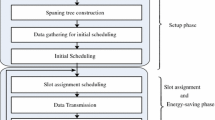Abstract
The rapid deployment of wireless sensor network helps to form a network in varieties of applications. For example, WSN can be used to perform data collection in war field. However the qualities of service of WSN depending on various operations like routing and scheduling. Numerous routing protocols are being addressed to solve the scheduling problems in wireless sensor networks. But they suffer with poor QoS values. To address these issues, an energy efficient multi attribute time slot scheduling (MATSS) algorithm is proposed in this paper. The algorithm is focused to extend the lifetime of sensor nodes with multi part dynamic routing (MPDR) neighbour conditions and previous time slot conditions. Based on both the values the node has been scheduled as sleep/wakeup mode and this will be performed for each time slot. The selection of node is performed according to the condition of neighbour nodes and energy parameter by sharing the information between them. The MPDR routing performs both shortest path routing and energy efficient longer route to maximize the network lifetime. Also it aims to maximize the throughput ratio. In the beginning the nodes are scheduled according to the protocol has been implemented in Network Simulator (NS-2) and It has been evaluated with different number of nodes. The MATSS algorithm schedules the node states based on previous state and neighbour conditions, this improves the throughput by 7.6% and reduces the latency up to 4 ms.















Similar content being viewed by others
References
Dargie, W., & Poellabauer, C. (2010). Fundamentals of wireless sensor networks theory and practice. Wiley.
Palaniappan, S., Prakasam, P., Vaithiyashankar, J., & Sayeed, S. (2015). Optimal design of wireless sensor network for providing Qos. In Proceedings on the international conference smart sensors and application (ICSSA), Kuala Lumpur, 26–28 May (pp. 65–70).
Leabi, K., & Abdalla, T. Y. (2015). Lifetime maximization in wireless sensor networks based on using data compression. International Journal of Computer Applications, 122(11), 45–51.
Sathyaprakash, P., Jayakumar, V., & Sayeed, S. (2016). Life time maximization of wireless sensor networks using group characteristics based dynamic wakeup time scheduling. Journal of Signal Processing and Wireless networks, 1(1), 13–18.
Edith Linda, P., Dinesh, S., & Edreena, P. (2014). Network lifetime maximization for estimation in multihop wireless sensor networks. International Journal of Advanced Research in Computer Science and Software Engineering, 4(11), 205–211.
Veeranji Reddy, N., & Jeba, L. (2014). Lifetime maximization in wireless sensor network. International Journal of Engineering Trends and Technology, 9(5), 218–222.
Karkvandi, H. R., Pecht, E., & Yadid, O. (2011). Effective lifetime-aware routing in wireless sensor networks. IEEE Sensors Journal, 11(12), 3359–3367.
Dohare, U., Lobiyal, D. K., & Kumar, S. (2014). Energy balanced model for lifetime maximization in randomly distributed wireless sensor networks. Wireless Personal Communications, 78(1), 407–428.
Wang, Y., & Li, G. (2012). An efficient data aggregation scheme in wireless sensor networks, internet of things. In International workshop, IOT 2012, Changsha, China (pp. 25–32).
Wang, D. (2006). A graph-center-based scheme for energy-efficient data collection in wireless sensor networks, Springer, Mobile Ad hoc and sensor networks, Lecture notes in computer science, 4325 (pp. 579–587).
Wang, B., Yang, X., Zang, W., & Yu, M (2014). Approximate self-adaptive data collection in wireless sensor networks In Wireless algorithms, systems, and applications lecture notes in computer science 8491 (pp. 564–575).
Li, Z., Liu, Y., Li, M., Wang, J., & Cao, Z. (2013). Exploiting ubiquitous data collection for mobile users in wireless sensor networks. IEEE Transactions on Parallel and Distributed Systems, 24(2), 312–326.
Khurana, P., & Aulakh, I. (2013). Wireless sensor network routing protocols: A survey. International Journal of Computer Applications, 75(15), 17–25.
Ghosh, K., Bhattacharya, P. P., & Das, P. K. (2012). Effect of multipath fading and propogation environment on the performance of a fermat point based energy efficient geocast routing protocol. International Journal of Wireless & Mobile Networks, 4(1), 215–224.
Khan, A. A., Javaid, N., Qasim, U., Lu, Z., & Khan, Z. A. (2012). HSEP: Heterogeneity-aware hierarchical stable election protocol for WSNs seventh international conference on broadband, wireless computing, communication and applications, proceedings (978-0-7695-4842-5/12) (pp. 373–378).
Gholipour, M., Haghighat, A. T., Meybodi, M. R. (2015).Hop-by-hop traffic-aware routing to congestion control in wireless sensor networks, Wireless Communication and Networking, November 12–14, Victoria, Canada 2015(15), pp. 1–13.
Amgoth, T., & Jana, P. K. (2015). Energy and coverage-aware routing algorithm for wireless sensor networks. Wireless Personal Communication, 18(2), 531–545.
Dwivedi, S. D., et al. (2012). Energy efficient routing algorithm with sleep scheduling in wireless sensor network. International Journal of Computer Science and Information Technologies, 3(3), 4350–4353.
Heinzelman, W. R., & Chandrakasan, A., & Balakrishnan, H. (2000). Energy efficient communication protocol for wireless microsensor networks. In IEEE Hawaii international conference on system sciences. 2 (pp. 1–10).
Bulut, E., Korpeoglu, I. (2007). Dssp: A dynamic sleep scheduling protocol for prolonging the lifetime of wireless sensor networks. In The proceedings of 21st international conference on advanced information networking and applications workshops, AINAW’07 (Vol. 2, pp. 725–730).
Hong, L., & Yang, J.(2009). An energy-balance multipath routing based on rumor routing for wireless sensor networks. In The proceedings of natural computation, ICNC’09. Fifth international conference on, 3 (pp. 87–91).
Kulik, J., Balakrishnan, H., & Heinzelman, W. R. (1999). Adaptive protocols for information dissemination in wireless sensor networks. In Proceedings on the 5th annual ACM/IEEE international conference on mobile computing and networking (pp. 174–185).
Braginsky, D., Estrin, D. (2002). Rumor routing algorithm for sensor networks. In Proceedings of the first workshop on sensor networks and applications (WSNA), Atlanta, GA (pp. 22–31).
Inagaki, T., & Ishihara, S. (2009). HGAF: A power saving scheme for wireless sensor network. Journal of Information Processing, 17, 255–266.
Author information
Authors and Affiliations
Corresponding author
Rights and permissions
About this article
Cite this article
Palaniappan, S., Periasamy, P. Proposed Energy Efficient Multi Attribute Time Slot Scheduling Algorithm for Quality of Service in Wireless Sensor Network. Wireless Pers Commun 97, 5951–5968 (2017). https://doi.org/10.1007/s11277-017-4821-z
Published:
Issue Date:
DOI: https://doi.org/10.1007/s11277-017-4821-z




